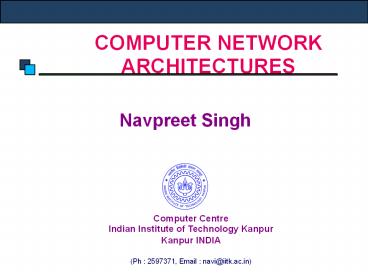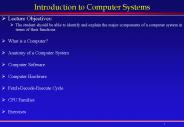COMPUTER%20NETWORK%20ARCHITECTURES - PowerPoint PPT Presentation
Title:
COMPUTER%20NETWORK%20ARCHITECTURES
Description:
COMPUTER NETWORK ARCHITECTURES Navpreet Singh Computer Centre Indian Institute of Technology Kanpur Kanpur INDIA (Ph : 2597371, Email : navi_at_iitk.ac.in) – PowerPoint PPT presentation
Number of Views:128
Avg rating:3.0/5.0
Title: COMPUTER%20NETWORK%20ARCHITECTURES
1
COMPUTER NETWORK ARCHITECTURES
- Navpreet Singh
Computer Centre Indian Institute of Technology
Kanpur Kanpur INDIA (Ph 2597371, Email
navi_at_iitk.ac.in)
2
Content
Content
- Introduction to Computer Networks
- Overview Of Network Architectures
- Campus Networks
- Residential Networks
- Enterprise Networks
- Internet
- How Web Works
- Network Internet Security
3
Computer Networks
Introduction to Computer Networks
- Computer network connects two or more autonomous
computers. - The computers can be geographically located
anywhere.
4
LAN, MAN WAN
Introduction to Computer Networks
- Network in small geographical Area (Room,
Building or a Campus) is called LAN (Local Area
Network) - Network in a City is call MAN (Metropolitan Area
Network) - Network spread geographically (Country or across
Globe) is called WAN (Wide Area Network)
5
Applications of Networks
Introduction to Computer Networks
- Resource Sharing
- Hardware (computing resources, disks, printers)
- Software (application software)
- Information Sharing
- Easy accessibility from anywhere (files,
databases) - Search Capability (WWW)
- Communication
- Email, Chat, VoIP
- Message broadcast
- Remote computing
- Distributed processing (GRID Computing)
6
Network Components
Introduction to Computer Networks
- Physical Media
- Interconnecting Devices
- Computers
- Networking Software
- Applications
7
Networking Media
Introduction to Computer Networks
- Networking media can be defined simply as the
means by which signals (data) are sent from one
computer to another (either by cable or wireless
means).
8
Networking Devices
Introduction to Computer Networks
- HUB, Switches, Routers, Wireless Access Points,
Modems etc.
9
Computers Clients and Servers
Introduction to Computer Networks
- In a client/server network arrangement, network
services are located in a dedicated computer
whose only function is to respond to the requests
of clients. - The server contains the file, print, application,
security, and other services in a central
computer that is continuously available to
respond to client requests.
10
Networking Protocol TCP/IP
Introduction to Computer Networks
11
Applications
Introduction to Computer Networks
- Searchable Data (Web Sites)
- E-Commerce
- News Groups
- Internet Telephony (VoIP)
- Video Conferencing
- Chat Groups
- Instant Messengers
- Internet Radio
12
Campus LAN Technology Options
Campus Networks
- Ethernet
- Fast Ethernet
- Gigabit Ethernet
- 10 Gig Ethernet
- WLAN
13
Campus Network Architecture
Campus Network
Server Farm
Router
Firewall
Backbone Switch
Internet
Distribution Switch
Access Switch
14
Campus Network Architecture
Campus Network
- Uses Three Tier Switching Architecture (Popularly
known as Ciscos Switching Architecture) - Backbone Switch
- Layer 3/4 Chassis based switch
- Multiple 100Fx or 1000SX/LX or 10GLX/LH ports for
connectivity to Distribution switches - Multiple 10/100/1000 ports for connectivity to
Servers - Distribution Switch
- Layer 2/3 Managed Fixed configuration switch
- 1/2 100Fx or 1000Sx/Lx or 10GLX/LH ports for
connectivity to the Backbone switch - Multiple 10/100 or 10/100/1000 ports for
connectivity to the Access switches - Access Switch
- Layer2 Managed/Unmanaged Fixed configuration
switch - Multiple 10/100 or 10/100/1000 ports for desktop
connectivity
15
Residential Networks Dial-up
MAN Technologies
- Uses POTS (Plain Old Telephone System)
- Provides a low cost need based access.
- Bandwidth 33.6 /56 Kbps.
- On the Customer End Modem is connected to a
Telephone Line - On the Service Provider End Remote Access Server
(RAS) is connected to Telephone Lines (33.6 Kbps
connectivity) or E1/R2 Line (56 Kbps
connectivity) - RAS provide dialin connectivity, authentication
and metering. - Achievable bandwidth depends on the line quality.
16
Residential Networks Dial-up
MAN Technologies
RAS
17
Residential Networks DSL
MAN Technologies
- Digital Subscriber Line (DSL) uses the Ordinary
Telephone line and is an always-on technology.
This means there is no need to dial up each time
to connect to the Internet. - Because DSL is highly dependent upon noise
levels, a subscriber cannot be any more than 5.5
kilometers (2-3 miles) from the DSL Exchange - Service can be symmetric, in which downstream and
upstream speeds are identical, or asymmetric in
which downstream speed is faster than upstream
speed. - DSL comes in several varieties
- Asymmetric DSL (ADSL)
- High Data Rate DSL (HDSL)
- Symmetric DSL (SDSL)
- Very High Data Rate DSL (VDSL)
18
Residential Broadband ADSL
MAN Technologies
19
Residential Broadband Mobile Wireless
MAN Technologies
- Use CDMA (128 Kbps) or GSM GPRS (384 Kbps) Mobile
Wireless
20
Enterprise WAN Network
Enterprise Network
21
Enterprise WAN Network
Enterprise Network
22
Enterprise WAN Network
Enterprise Network
Server Farm
Corporate Head Office
Branch Office
Service Provider Network
Branch Office
All the locations are connected through a Service
Provider Network over MPLS Backbone
Branch Office
23
Internet
Internet
ISP network
ISP network
Backbone ISP Networks
Bandwidth-limitedlinks
ISPnetwork
- Customers connect to a National ISP
- National ISPs connect to International Backbone
Networks
Customer Networks
24
Service Provider Networks Reliance
Service Provider Network
25
Service Provider Networks Reliance
Service Provider Network
- Reliance Data Centers, are connected to 132
countries across 4 continents spanning US, UK,
Mid-east and Asia-Pac through Flag Telecom
backbone (Reliance Infocomm 's group company) and
other undersea cable systems like Se-Me-Wea-3 and
i2i and are having public / private peering
relationship with large Tier 1 ISPs and content
providers at more than 15 Internet Exchange
points across the globe. There also exists
peering relationship with other popular domestic
ISPs on STM-1 bandwidth levels. - The data centers further are connected to
Reliance's country wide optic fiber based IP
network with terabytes of capacity having points
of presence at more than 1100 cities. Customers'
can access the Internet by connecting to any of
these 1100 PoPs using multiple means like local
dedicated leased lines, PSTN -ISDN dialup links
OR simply by using Reliance's 3G CDMA mobile
services. - The Reliance Data Centers at various locations
are also interconnected through redundant fiber
ring with bandwidth capacity of STM-4 for data
replication purposes for providing Disaster
Recovery services.
26
Service Provider Networks FLAG
Service Provider Network
27
Service Providers
Service Provider Network
- National Service Providers
- VSNL
- Reliance
- BSNL
- Bharti
- Satyam
- International Service Providers (connecting India
to the World) - Flag
- SingTel
- NIXI (STPI Delhi, Mumbai, Kolkata Chennai)
provides peering connectivity between Indian ISPs
28
How Web Works?
WWW
- Let's say you want to visit the google website.
- First you enter the address or URL of the website
in your web browser. - Then your browser requests the DNS Server to get
the IP address of the web server
29
How Web Works?
WWW
- Then your machine sends an HTTP request to the
web server that hosts the google site. - The server sends the data over the Internet to
your computer. - Your web browser interprets the data, displaying
it on your computer screen.
30
DNS Resolution
DNS
- DNS is a network service that enables clients to
resolve names to IP address. - A DNS server maintains the name to IP address
mapping of the domain for which it is the name
server - The DNS server for a domain is registered with
the domain registrar and the entry is maintained
by the root-servers. - Whenever a DNS for a server is queried, the root
servers are contacted. - The root servers replies with the IP address of
the DNS server of the domain (for higher level
domains) or forwards the request to the country
root servers (four country specific domains).
31
Load Balancing
DNS
- DNS supports Load Balancing The same name
resolves to multiple IP Addresses (IP addresses
of different Mirrored servers). - Companies like akamai provide "Enhanced DNS"
services - Different DNS results based on source IP.
- Web browser could automatically be directed to
the closest web server thus reducing the download
time - Companies like akamai maintain mirror sites of
many organizations on their server and direct
request for these sites to the nearest server.
32
INTERNET Security
- INTERNET SECURITY
33
INTERNET Security Threats
INTERNET Security
- Hacking
- DoS
- Reconnaissance
- Malwares
- Mail SPAM
- Phishing
- Botnets
34
Prevention Techniques
INTERNET Security
- Some of the prevention tools include
- Network Firewall
- Host Firewall
- IDS/IPS
- Mail Antispam and Antivirus Appliances
- UTM Appliances
- Application and OS Hardening
35
WLAN Security
INTERNET Security






























